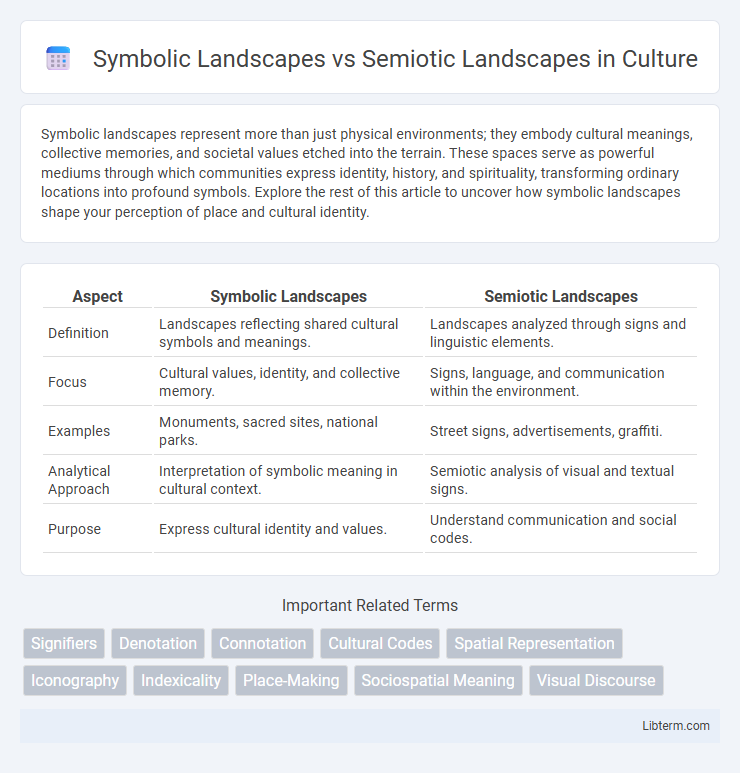Symbolic landscapes represent more than just physical environments; they embody cultural meanings, collective memories, and societal values etched into the terrain. These spaces serve as powerful mediums through which communities express identity, history, and spirituality, transforming ordinary locations into profound symbols. Explore the rest of this article to uncover how symbolic landscapes shape your perception of place and cultural identity.
Table of Comparison
| Aspect | Symbolic Landscapes | Semiotic Landscapes |
|---|---|---|
| Definition | Landscapes reflecting shared cultural symbols and meanings. | Landscapes analyzed through signs and linguistic elements. |
| Focus | Cultural values, identity, and collective memory. | Signs, language, and communication within the environment. |
| Examples | Monuments, sacred sites, national parks. | Street signs, advertisements, graffiti. |
| Analytical Approach | Interpretation of symbolic meaning in cultural context. | Semiotic analysis of visual and textual signs. |
| Purpose | Express cultural identity and values. | Understand communication and social codes. |
Introduction to Symbolic and Semiotic Landscapes
Symbolic landscapes represent spaces imbued with cultural meanings and collective identities shaped by historical narratives, monuments, or religious symbols. Semiotic landscapes encompass a broader range of signs and symbols, where text, images, and objects interact to convey social messages within public spaces. Understanding the distinction is crucial for analyzing how environments communicate meanings through both tangible symbols and dynamic sign systems.
Defining Symbolic Landscapes
Symbolic landscapes are defined by the meanings and cultural values that societies attribute to physical spaces, reflecting collective identity and historical narratives. These landscapes serve as tangible representations of societal beliefs, power structures, and memory, often embodied in monuments, religious sites, or public squares. Unlike semiotic landscapes, which emphasize the communication of signs and language through visual symbols, symbolic landscapes prioritize the deeper cultural and emotional significance embedded in the environment.
Understanding Semiotic Landscapes
Semiotic landscapes represent the dynamic interplay of signs, symbols, and cultural messages embedded within physical spaces, reflecting social meanings and identities. These landscapes convey complex cultural narratives through language, images, and symbols that interact with viewers' interpretations, shaping their understanding of place and community. Unlike symbolic landscapes, which focus on fixed meanings, semiotic landscapes emphasize the fluid and contested nature of meaning-making processes in public spaces.
Key Differences Between Symbolic and Semiotic Landscapes
Symbolic landscapes convey meaning through culturally specific symbols embedded in physical spaces, reflecting shared values and collective identity, while semiotic landscapes incorporate a broader range of signs and codes, including language, images, and physical markers that communicate social, political, or economic messages. Symbolic landscapes often emphasize heritage and tradition through monuments or sacred sites, whereas semiotic landscapes are dynamic, constantly reshaped by changing social discourses and media influences. The key difference lies in symbolic landscapes' focus on fixed cultural symbols, contrasted with semiotic landscapes' fluid, multi-layered interpretive signs that require active reading for meaning.
Historical Context and Evolution
Symbolic landscapes are shaped by cultural meanings and historical events, reflecting collective identity and memory through monuments, architecture, and spatial arrangements. Semiotic landscapes evolve from the interplay of signs and symbols in public spaces, incorporating linguistic elements such as signage, advertisements, and graffiti to communicate social and political messages. The historical context of symbolic landscapes often grounds them in tradition and heritage, whereas semiotic landscapes dynamically respond to contemporary cultural and social shifts.
Theoretical Frameworks and Influences
Symbolic landscapes are constructed through cultural and collective meanings embedded in physical spaces, influenced by theories of cultural geography and phenomenology that emphasize human experience and identity formation. Semiotic landscapes draw on semiotics and linguistics, focusing on signs, symbols, and language as systems of communication that shape interpretation and social interaction within a space. Both frameworks intersect in exploring how meaning is produced and negotiated through material and discursive practices but differ in their analytical emphasis on symbolic representation versus signification processes.
Real-world Examples of Symbolic Landscapes
Symbolic landscapes, such as the Statue of Liberty in New York or the Eiffel Tower in Paris, embody cultural values and identity through recognizable landmarks that convey historical or ideological significance. These landscapes represent collective memory and social meaning, contrasting with semiotic landscapes which emphasize the interpretation of signs and language in the built environment. Real-world symbolic landscapes serve as powerful tools for national pride, tourism, and cultural expression by encapsulating complex narratives within physical spaces.
Case Studies of Semiotic Landscapes
Semiotic landscapes are analyzed through case studies that reveal how public spaces communicate cultural, political, and social messages via signage, graffiti, and architectural elements. Unlike symbolic landscapes, which emphasize fixed meanings and historical symbolism, semiotic landscapes prioritize the fluid interpretation and contested meanings shaped by community interactions and power dynamics. Case studies often highlight urban environments like protest sites or multicultural neighborhoods, demonstrating how semiotic markers negotiate identity and social narratives in real-time.
Impact on Cultural Identity and Perception
Symbolic landscapes, embedded with culturally significant symbols and monuments, actively reinforce collective memory and shared cultural identity by evoking historical narratives and values. Semiotic landscapes communicate multifaceted social meanings through signage, language, and visual codes, shaping perceptions by reflecting and contesting power dynamics within a community. Both landscapes impact cultural identity by influencing how space is experienced, interpreted, and linked to social belonging and cultural expression.
Future Directions in Landscape Studies
Future directions in landscape studies emphasize integrating Symbolic and Semiotic Landscapes to deepen understanding of cultural identity and spatial communication. Advancements in digital mapping and geospatial analysis enable researchers to decode complex layers of symbolism and signification embedded in landscapes. Emerging interdisciplinary approaches harness semiotics and cultural geography to explore dynamic interactions between people and places, informing sustainable and inclusive urban design.
Symbolic Landscapes Infographic

 libterm.com
libterm.com